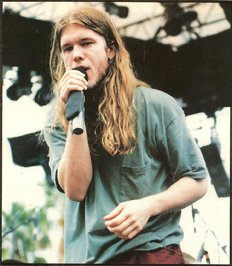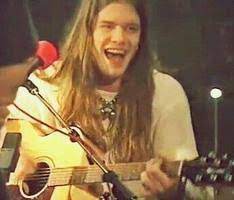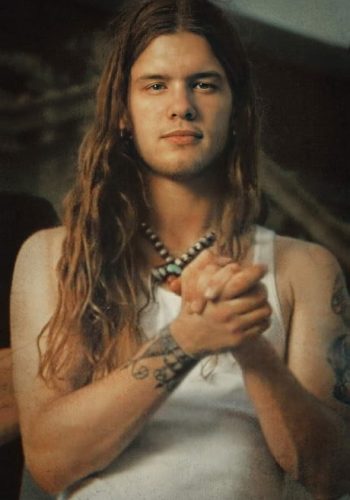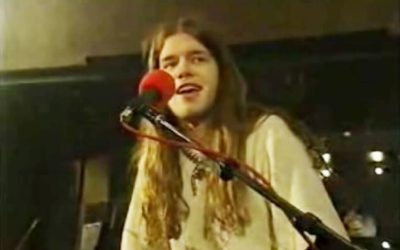A Site About Dead Musicians and How They Got That Way

Shannon Hoon: Age 28 | Cause Of Death: POOR MAINTENANCE
(Died: October 21, 1995)
Blind Melon released their second album, Soup, late in the summer of 1995. The album received better reviews than its predecessor, yet it failed to produce a hit single. The group launched an extensive tour that fall to promote Soup that turned out to be ill-fated. Shannon Hoon was found dead on the band’s tour bus in New Orleans on Saturday October 21, 1995 of a reported drug overdose; he was 28 years old. ~AMG ~Hoon’s tragic death in New Orleans (October “95) [was] from an accidental cocaine overdose. ~Blind-Melon .com
Obituary
From the New York Times’ Obituary page, October 23, 1995:
Shannon Hoon, lead singer of the rock group Blind Melon, died on Saturday in the band’s tour bus in a parking lot in New Orleans. He was 28 and lived in Lafayette, Ind. The cause was apparently an accidental drug overdose. Blind Melon achieved rapid success with its self-titled first album. The video for “No Rain” was so popular that its images of a cavorting girl dressed in a bee costume threatened to eclipse the band.
In high school, Mr. Hoon developed a reputation for misbehavior. Recently Mr. Hoon moved back to Lafayette with his girlfriend of 10 years, Lisa Crouse, and a daughter, Nico Blue, was born to them this summer. In addition to his mother, daughter and Ms. Crouse, Mr. Hoon is survived by his father, Richard; a sister, Anna, and a brother, Tim.
Commentary by Chris Heath
That’s what life can shrivel into: an overdose, a bee girl, a few leftover family members. There wasn’t much fuss when Shannon Hoon died. He wasn’t famous enough or ironic enough. His body gave out as Blind Melon toured America’s clubs, trying but failing to interest the world in their second album, Soup.

The Monday after his death, a new Blind Melon video, “Toes Across the Floor,” was serviced to MTV, as previously planned. You might have thought they would have played it a bit, whatever they thought of the video or the song; it did show the last public cavortings of a singer whom, two years before, they had joyously force-fed their audience. They didn’t. In fact, the single’s tepid recognition – the embarrassed way it was ignored – acted as a perfect metaphor for the death with which it coincided. The truth is that Shannon Hoon’s death was treated – was reviewed – exactly as if it were a new Blind Melon single. And in October 1995 there were few less valuable pop commodities than a new Blind Melon single.
I’m as swayed by pop culture’s violent and callous mood swings as anybody, and maybe I would have also reacted to his death as an inconvenience and an irrelevance, if not for a few curious days in 1993 when I went on tour with Blind Melon. I went somewhat unwillingly – I needed some time at home, and I didn’t consider it a peach of an assignment – but Details wanted to respond quickly to the band’s sudden celebrity. So I went, and something about the experience stayed with me. Particularly Shannon Hoon. He was crazy and rude, and yet also unbearably sweet. It seemed as though he couldn’t make up his mind whether to fight me, avoid me, or make me love him.
Then there was the matter of the lighter. It was an Elvis Presley lighter, slightly worn, bought in Memphis. Shannon would sit on the tour bus, the lighter in one hand, cradling his bong with the other. Midway through my visit, Elvis spluttered and stopped. Shannon Hoon and I had developed an odd relationship, with plenty of jostling. He walked out of two interviews; I soon realized that the only way to deal with him was not to indulge him but to be equally rude back. Somewhere along the way, we got on quite well. There was an incredible spirit around him, wanton and careless, but also somehow innocent and invigorating. On my last evening, he suddenly passed me his spent lighter, clearly intending it as some kind of strange act of friendship.
Retrospective
A Cautionary Tale When 'Behind The Music' Hits Home
The life and times of Shannon Hoon, the late lead singer of Blind Melon and a Lafayette native, were built for VH1’s Behind the Music. A charismatic rise to Top 40 fame. An often-troubled backdrop where private demons were in full view of fans, friends and family. And a wealth of homemade video that chronicled all the most private bits backstage — rolls and rolls of the stuff that must have made producers of the popular rockumentary profiles absolutely drool.

And there it all was, in Sunday night’s unblinking premiere, dedicated to a mercurial life relegated too soon to the murals of dearly departed rockers on the exterior walls of JL Compact Discs in West Lafayette. (As fans of the Behind the Music franchise know, episodes are repeated ad nauseam, so there will be ample opportunity to catch up.)
Hoon was an unforgettable, and unpredictable, sort, who had a knack for truth-telling that could be both endearing and branding. He was going to live, and he let everyone around him know it, sometimes to an extreme fault. He rode that unbridled character to a national recording contract, the hit song of the summer of 1994 (“No Rain”) and the ultimately stereotypical rock star demise — death from a drug overdose on the bunk of a tour bus in 1995.
No doubt timed to coincide with today’s release of a new DVD retrospective of Hoon’s years with Blind Melon, Behind the Music did its job, right down to the condescending view of a small-town Lafayette. (Really, it’s not VH1’s job to play Greater Lafayette Chamber of Commerce, even if it missed the love quotient in Hoon’s love-hate relationship with his hometown. Hoon was honest that he once feared Lafayette might swallow him into a blue-collar existence, but he never shirked roots that drew him back and always seemed to make him more Lafayette than L.A.)
Unintentionally, probably, is the episode’s timing as a cautionary tale, one that comes at the heart of Recovery Month, a month devoted by U.S. Health and Human Services to understanding addictions and overcoming them. Hoon was consumed by a habit that he freely videotaped and one that band mates described as fun at first, as a simple feeding of the beast at the spiraling end. Rehab couldn’t prevent the relapse. Neither could fatherhood. The VH1 interviews and selections from Hoon’s journals stand as stark testimony.
Another casualty of rock excess, critics say. Without question, they’re correct. But the look off-stage at the props and a plot of a star-powered story that was almost too easy to tell offers a telling glimpse at what must go on behind the scenes of the addicts in our own midst and the minefields their families step through daily.
If for no other reason, it makes this Behind the Music family viewing of the most painful sort. Hoon, still the truth-teller, probably wouldn’t have it any other way.
Biography
Although they may vehemently disagree, Blind Melon (comprising singer Shannon Hoon, Roger Stevens [guitar], Christopher Thorn [guitar], Brad Smith [bass], and Glen Graham [drums]) fits neatly into the new-hippie movement of the early ’90s. While their music is not psychedelic like the Grateful Dead’s, Jefferson Airplane’s, or even Phish’s, it has the same vibe, the same feeling — a call for love, peace, understanding, and good, rocking times. Blind Melon has a harder, guitar-based edge than most hippies, which explains why Axl Rose championed them and featured their lead singer, Shannon Hoon, in Guns N’ Roses’ single and video, “Don’t Cry.” If anything, Blind Melon’s 1993 breakthrough hit single, the breezy “No Rain,” is deceiving; it may capture their spirit faithfully, but the rest of their music favors louder, more meandering guitar jams like the follow-up single, “Tones of Home.” Blind Melon released their second album, Soup, late in the summer of 1995. The album received better reviews than its predecessor, yet it failed to produce a hit single. The group launched an extensive tour that fall to promote Soup that turned out to be ill-fated. Shannon Hoon was found dead on the band’s tour bus in New Orleans on Saturday October 21, 1995 of a reported drug overdose; he was 28 years old. After releasing the rarities collection Nico, Blind Melon announced that the remaining members would carry on performing under a different name. — Stephen Thomas Erlewine, All-Music Guide


